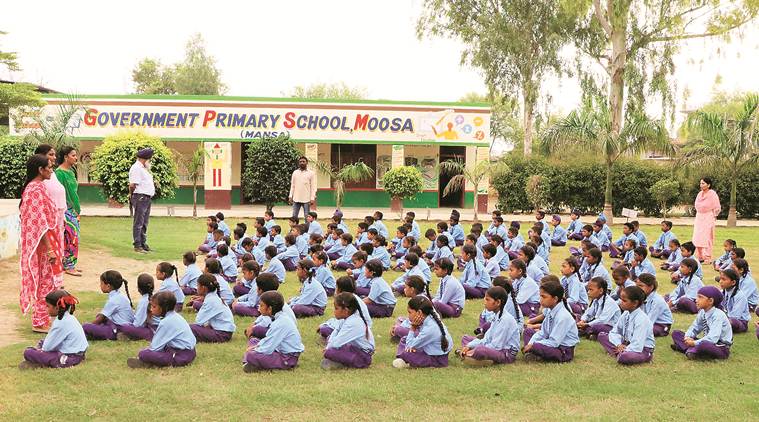
In 2002, when Jagjit Singh Walia joined as an elementary teacher, the sight that greeted him at the Government Primary School in Moosa, in Punjab’s Mansa district, was of children sitting in corridors, a few others in the sun, and still others running around in the open ground. There were not enough classrooms, no toilets, and the building didn’t inspire confidence. Walia knew exactly where to start — the school didn’t have a gate, and stray animals and trespassers walked in and out. So he, along with the other teachers, approached then sarpanch Balwinder Singh and sought donations to install a gate.
Today, the school — brightly painted with eight rooms for classes 1 to 5, including a computer lab/library and a cluster resource centre, and with teaching aids, lush green lawns and a playground — is one of 3,400 smart schools in Punjab.
While the official school timings are until 2 pm in summer and 3.15 pm in winter, the school is open from 8 am to 8 pm through the year. After the regular classes, students go home for about an hour, eat their lunch, take a break, and come back to school at 4 pm. They then do their homework for about an hour — and from 5 pm, there are classes for kabaddi and athletics for the students. The school also runs an evening music class in association with Pracheen Kala Kendra, an educational organisation, with its students consistently winning state-level competitions.
Walia, who is now in charge of the school, says, “We also train them for debate, painting, bhangra and giddha competitions. A few of our ex-students, who are now in high school, come here to do their homework, after which they too assist us. The students go home only by 7-7.30 pm.”
Kabal Singh, a farmer and resident of Moosa village who is chairman of the School Management Committee, says, “Walia and the other teachers turned the school around. After they came to the village seeking a gate and the village panchayat installed one, they were inspired to do more. For instance, there were no toilets in the school, a major reason why we never enrolled our children here. Walia initially began with free bhangra classes after school hours, which drew a lot of youngsters. Once he built a rapport with them, these youngsters gathered bricks from the village and got masons to volunteer and build toilets. The youth club of school had Rs 3,500 in its kitty which they contributed to paint the school.” Kabal’s three children studied here, of whom two are now in the Government High School in the village while the youngest is in Class 5 in the primary school.
Around 2003, funds started coming in under the Sarva Siksha Abhiyaan and construction of new rooms started. Today the school has five regular teachers for the primary classes (Class 1-5), two volunteers for the pre-primary sections (nursery and KG) and one Inclusive Education Volunteer for 10 special children.
As the condition of the school improved, villagers moved their children from private schools to the Moosa primary school.
“Villagers realised that government schools can be as good as, even better than, private schools. Today, we have 235 students in our school, including 49 in the pre-primary classes. No child in the village studies in a private school and this is the badge of honour that we wear with pride,” says Walia, who travels 10 km to the school from Mansa city where he lives.
“Since 2002, approximately Rs 32 lakh has been spent on the school building, including on the construction of new class rooms. Of this, Rs 17 lakh was spent by the government while the rest came through donations,” he says, adding that every year, around “2-3 students from the school clear the Jawahar Navodya Vidhalaya entrance test”.
Early 2018, the Punjab government declared it a smart school, another validation of its efforts. The concept of smart schools was introduced by the state government in 2018 to empower government-run primary and secondary schools.
Binder Singh, a brick kiln labourer whose daughter Jyoti Kaur is in Class 5 at the Moosa school, says, “My daughter used to skip classes regularly and we never pushed her either. She would help her mother at home or accompany us for NREGA work. She could sing well, but we thought what use is it to anyone? But for the past one year, she has been regularly going to school and stays back for music classes. Her teachers have also told us that they will support Jyoti.”
Last year, Kaur won the second prize in the folk-song category at a state-level inter-school music competition.
Walia says, “Earlier, Jyoti hardly came to school and we had to counsel her as well as her parents. But once she started coming, she began doing well in academics and we helped her hone her singing skills too. She scored more than 80 per cent marks in Class 4.”
Talking about the initiatives of the Moosa school, Punjab School Education and Public Works Minister Vijay Inder Singla said, “I am overwhelmed to know that people prefer the government school in Moosa village to private ones. The Moosa school has set an example for other schools by becoming a smart school even before the government could give it the tag. Under our smart school policy, which is proposed to be implemented next week, the government will revamp all the 19,000 government schools in the state by providing 50 per cent of the financial support needed to revamp schools, with the community pitching in with the remaining 50 per cent.”